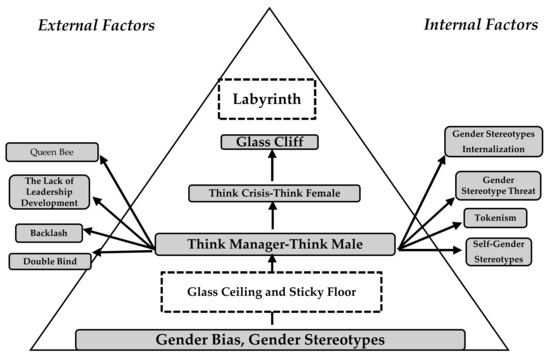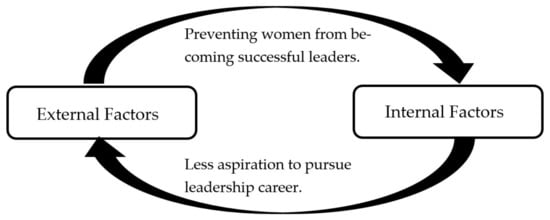A part of diversity management is working to achieve gender equality and create a comfortable working environment for women. However, in many organizations, gender biases and stereotypes frequently occur, consciously or unconsciously, regardless of whether women take on leadership roles. In addition, women must overcome a variety of challenges when taking on leadership roles or aspiring to become leaders. Based on the above background, wthe researchers review and integrate the literature on management and career studies related to the challenges that women face in the process of advancing to leadership positions in organizations. Specifically, we the researchers examine the external and internal factors that create the various obstacles that women who aspire to leadership positions in structured organizations face from a gender perspective. Based on the integrative review, we discuss the implications for practices to increase the number of female leaders.
1. Gender Stereotypes as Internal Factors
Based on the literature that wthe researchers have reviewed so far, wethey developed an integrative model that summarizes the external and internal factors that create the barriers that female leaders face in their careers and as leaders within organizations. Figure 1 illustrates the integrative model. The model shows that the challenges that women face in their careers are driven by general types of gender biases and stereotypes, beginning at the point of entry into the organization and continuing through the early stages of their careers.
Figure 1.
An Integrative Model: Challenges Women Experience in Organizations.
Although women generally face challenges stemming from gender bias and stereotypes, women who aspire to leadership positions encounter additional leadership and personal career challenges. As a result, gender bias and stereotypes prevail throughout women’s careers at all levels, creating various challenges in their career trajectories within organizations
[7,8][1][2].
OuThe researcher
s' model also suggests that many organizations are structured as masculine from the gender perspective. The gender stereotype-based structure of organizations can influence the perceptions and behavior formation of male and female leaders, even though nothing is inherently gender-related about them
[5][3]. In other words, gender bias and stereotypes within organizations implicitly determine what women should and should not do, which creates both external and internal factors that affect women’s leadership careers.
2. External Factors Affecting Women’s Leadership Careers
Figure 1 depicts the various stages that women encounter in their career progression that are influenced by gender biases and stereotypes. To become leaders at each stage, women must first overcome the glass ceiling. Failure to do so will result in them remaining in low positions on the sticky floor. Even if they do succeed in shattering the glass ceiling, they advance into the labyrinth, where they encounter additional gender stereotype-based selection biases. The figure also suggests that in organizations, various selection biases based on the think manager–think male phenomenon tend to place men in desirable leadership positions and women in undesirable leadership positions. The think manager–think male biases are the major cause of double bind, backlash, lack of leadership developments, and the queen bee syndrome, all of which hinder the growth of female leaders.
Based on the notion of men as leaders, women face the double bind of contradiction with societal gender-stereotypical expectations. This contributes to backlash when women behave differently from gender stereotypes. The backlash has negative consequences such as punishment or reinforcing traditional attitudes and behaviors toward women. Due to the double bind and backlash, women oscillate between masculine (assertiveness, competitiveness, etc.) and feminine (compassion, empathy, etc.) traits that are necessary for leadership, and they are subjected to social pressure to decide which traits to emphasize. In addition, because women are not seen as leaders compared to men, organizations can lack leadership development, where contributions to and support for leadership development and capacity building are not provided. Furthermore, male-dominated organizations are more prone to the queen bee phenomenon, contributing to maintaining a glass ceiling in the organization.
Even after women break through the glass ceiling and they are chosen as leaders, they find themselves near the glass cliff in the labyrinth of their careers. The think crisis–think female effect contributes to a glass cliff for female leaders. In addition, because women often work for less compensation than men with comparable experience and skills, organizations may exhibit selection bias in favor of women in dangerous situations
[14,64][4][5]. Therefore, women tend to be placed in a disadvantaged or precarious position, even when a higher status is granted
[64][5]. Women leaders are not only expected to possess skills that are on par with their male counterparts, but also to demonstrate leadership styles that are indicative of their suitability as leaders.
Gender biases and stereotypes persist, and women who break through the glass ceiling and survive the glass cliff still face the labyrinth of their careers. The selection bias of the think manager–think male or think crisis–think female phenomenon does not disappear simply because a woman has been chosen as a leader. Therefore, women leaders must perform under adverse conditions and in precarious positions. If they can overcome the glass cliff and labyrinth, they can earn respect as leaders. However, if they cannot overcome these obstacles, they may lose confidence, perceive themselves as incompetent, internalize gender stereotypes, and consequently shift from external factors to internal factors.
3. Internal Factors Affecting Women’s Leadership Careers
Figure 1 shows that gender biases and stereotypes developed from an organization’s influence on women’s self-perceptions and values of unfitness to lead, leading to gender stereotype internalization. This leads to female leaders self-limiting their career choices because they believe they cannot fulfill leadership roles. For example, women leaders tend to behave in ways that are consistent with gender stereotypes. Therefore, even when women overcome the glass ceiling, it leads to a lack of confidence in their leadership presence.
Tokenism suggests that women aspiring to leadership positions feel pressure to prove themselves and perform at a higher level than their male counterparts to justify their position. This pressure can lead to anxiety and stress, and it could potentially affect their performance and ability to lead effectively. They may lose confidence, feel like an imposter, and further affect their performance and self-esteem. They may also be subjected to gender stereotype threats to attain those positions because social stereotypes expect men to be the leaders, which may cause women to lose confidence and feel that they do not belong to the leadership field. As a result, women tend to internalize self-gender stereotypes, which can further result in their gender-stereotypical identities
[90][6], a lack of confidence in their abilities and achievements
[66[7][8],
78], and a lack of leadership skills and assertiveness
[76][9].
In summary, both the external and internal factors derived from gender stereotypes become factors that limit women’s leadership and careers. Therefore, to build a career as a female leader, it is necessary to challenge gender stereotypes based on the concept of leadership
[92][10].
4. Vicious Cycle That Manifests Leadership Challenges for Women
As shown in the above section, both the external and internal factors based on gender stereotypes have a negative effect on women’s careers.
Figure 2 shows that external factors such as gender bias and gender stereotypes within organizations may cause women to underestimate themselves and their self-efficacy
[80][11], which causes a vicious cycle in which challenges to women in leadership manifest over time. For example, although organizations are responsible for appointing women to leadership positions and offering promotion opportunities, gender stereotypes and biases within the organization increase the possibility that women are appointed to disadvantageous or unstable positions due to unfavorable organizational conditions. Therefore, when women are appointed to leadership positions, the organization may judge women more harshly than men. This accelerates the internalization of gender stereotypes among female leaders such that they feel incapable in leadership roles or that their skills are inadequate. Female leaders may believe that they are not qualified for career positions
[6[6][12],
90], leading to the underestimation of their leadership identity and a lack of self-confidence.
Figure 2.
Vicious cycle between external and internal factors.
The internalization of gender stereotypes and the resultant low self-confidence and low performance as leaders, as well as the avoidance of leadership roles and self-limitations of career choices, further reinforce the gender biases and stereotypes within organizations, which stabilize and even strengthen the external factors that prevent women from pursuing leadership roles. The repetition of this vicious cycle can limit the possibility of women being appointed to leadership positions and restrict their career growth. Therefore, if organizations make decisions based on gender stereotypes, they cannot expect women to excel and succeed in top management positions.


